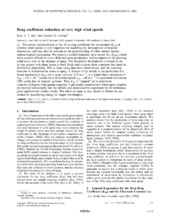Drag coefficient reduction at very high wind speeds
Peer reviewed, Journal article
Permanent lenke
https://hdl.handle.net/1956/1152Utgivelsesdato
2006-03-31Metadata
Vis full innførselSamlinger
- Geophysical Institute [1198]
Originalversjon
https://doi.org/10.1029/2005jc003114Sammendrag
The correct representation of the 10-m drag coefficient for momentum (K10) at extreme wind speeds is very important for modeling the development of tropical depressions and may also be relevant to the understanding of other intense marine meteorological phenomena. We present a unified boundary layer model for (K10), which takes account of both the wave field and spray production, and asymptotes to the growing wind wave state in the absence of spray. The theoretical development is based on an air-sea system with shear layers in both fluids and contains three constants that must be determined empirically. This is done using data from observations, and the resulting behavior is interpreted in terms of spray. A feature of the results is the prediction of a broad maximum in K10. For a spray velocity of 9 m s-1, it is found that a maximum of K10 ~ 2.0 × 10-3 occurs for a 10-m wind speed, u10 ~ 40 m s-1, in agreement with recent GPS sonde data in tropical cyclones. Thus K10 is ‘‘capped’’ at its maximum value for all higher wind speeds expected. A physically based model, where spray droplets are injected horizontally into the airflow and maintained in suspension by air turbulence, gives qualitatively similar results. The effect of spray is also shown to flatten the sea surface by transferring energy to longer wavelengths.
